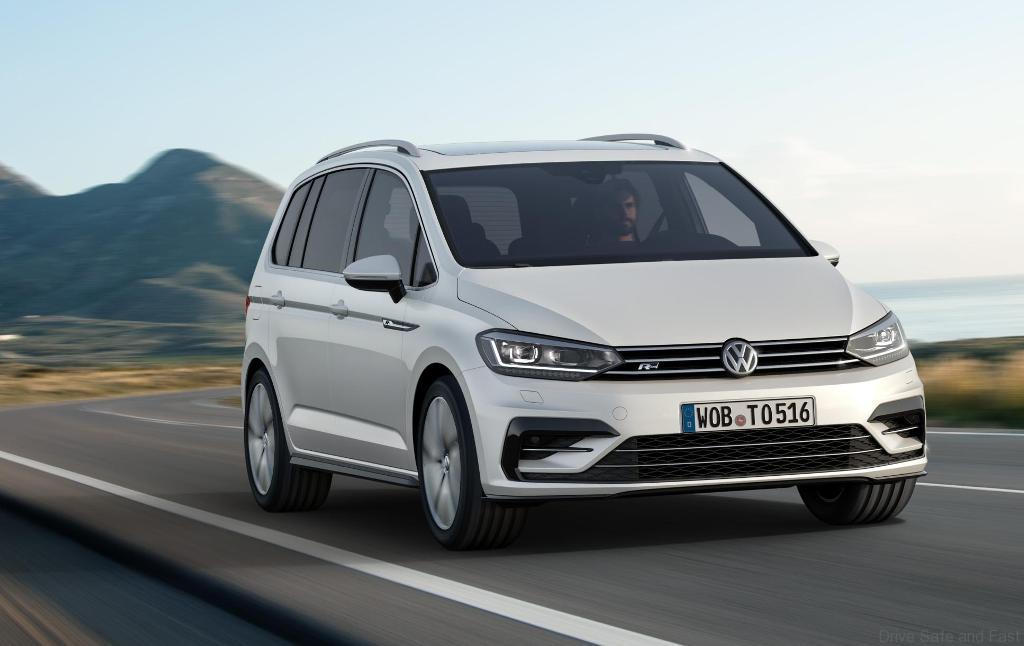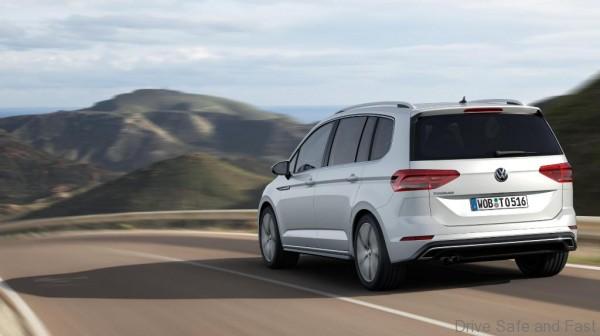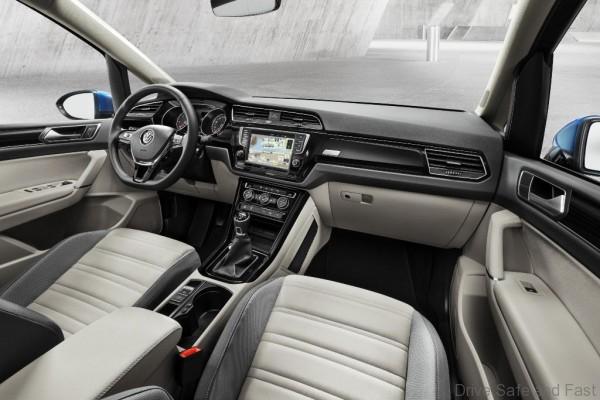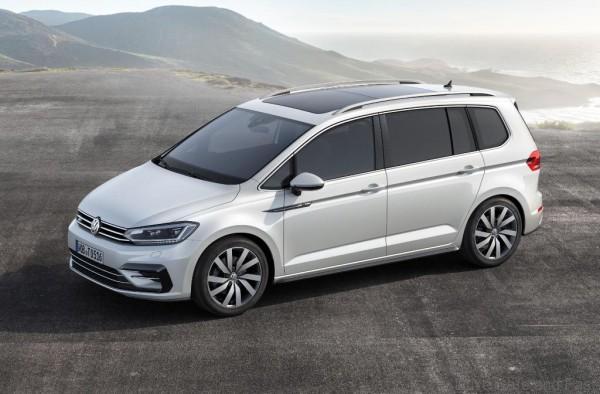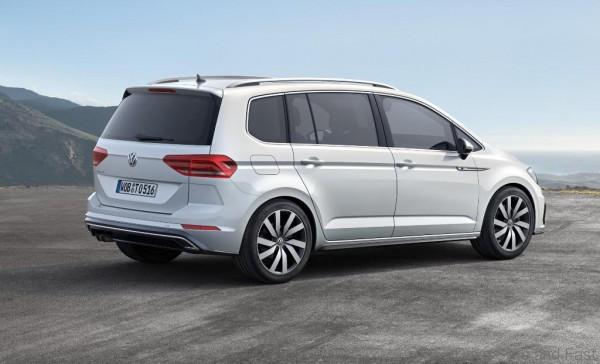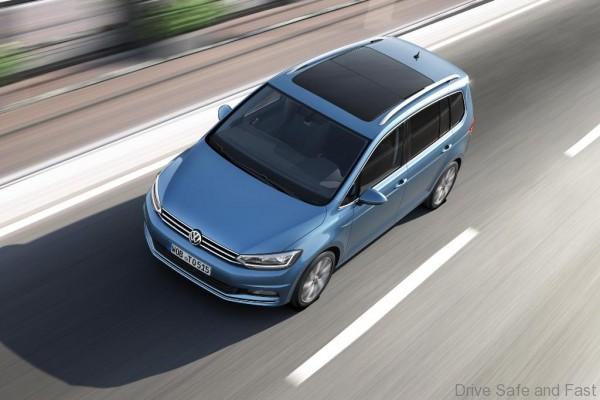The Touran is Germany’s most successful compact MPV. It’s a highly versatile companion for all journeys, characterised by an impressive use of space and meticulous attention to detail throughout. Volkswagen is now launching a new generation; completely re-conceptualised version of this popular all-rounder, which has already hit sales of some 1.9 million units in Europe, Asia and Africa. Dr Heinz-Jakob Neußer, Board Member for development of the Volkswagen brand, says: “The new Touran is the first multi-variable MPV to be built on the Modular Transverse Matrix (MQB) basis developed by Volkswagen.
This brings many advantages as far as design and construction are concerned – including, for example, much more powerful-looking exterior proportions and a distinctive long wheelbase with very short body overhangs enabling us to achieve a groundbreaking use of space.” At the same time, Volkswagen has succeeded in reducing the weight of the new Touran, as it has already done with other MQB-based models. “And that is despite a 130 mm increase in the overall vehicle length as well as greater demands on safety and comfort,” says Dr Neußer. “We saved up to 62 kg in weight compared with the predecessor.” This weight reduction was achieved through the use of innovative lightweight construction technologies in the drive systems and bodywork.
Up to 19 per cent* lower fuel consumption. The reduction in weight results directly in a drop in fuel consumption. The same is true of the excellent aerodynamics. According to Dr Neußer, “We have succeeded in reducing the drag coefficient to 0.296, an exceptionally good result for a family MPV.” In addition to this, the new or refined and more powerful turbocharged engines contribute to making the 2015 Touran one of the most sustainable and agile MPVs on the market. This is because the engines, three petrol (81 kW / 110 PS, 110 kW / 150 PS, 132 kW / 180 PS) and three diesel (81 kW / 110 PS, 110 kW / 150 PS, 140 kW / 190 PS), are now up to 19 per cent* more economical. The most fuel-efficient diesel model, the 110 PS Touran 1.6 TDI with 7-speed DSG, uses only 4.1 l/100 km*. “A seven-seater MPV like the new Touran 1.6 TDI with 110 PS that consumes a mere 4 litres per 100 km may well be considered a milestone in sustainability,” says Dr Neußer. The most economical petrol-driven model is the Touran 1.4 TSI, which delivers 150 PS while achieving an average fuel consumption of 5.4 l/100 km* when combined with the optional 7-speed dual clutch gearbox. All models feature Stop/Start and battery regeneration (brake energy recuperation) systems as standard.
Powerful design. Volkswagen has also completely revamped the vehicle’s design, right down to the last detail. Klaus Bischoff, Head Designer for the Volkswagen brand, says: “The Touran’s new powerful and precise design picks up the reductive clarity of the previous model. We refined the design concept, reinventing it in places to give it a sharper look while retaining a strong underlying continuity. What emerges is an original with a much enhanced light and sporty look thanks to the long side windows and precise lines.”
R Line packages. The Touran looks particularly sporty when fitted with the new R Line exterior equipment range from Volkswagen R. The R Line exterior package includes special R Line bumpers among other features. Inside, the R Line interior package contains highlights such as the exclusive seat covers.
Interior with fold-flat seat system. The designers have also completely restyled the high grade interior. The design concept here also aimed to achieve a reduction in weight, which was accomplished thanks to the newly developed fold-flat seat system. The second row seats are now much lighter, for example, and can be folded down to merge flat with the luggage compartment floor. This enables the Touran to provide a maximum amount of space on the smallest footprint. Even with five people on board, this MPV has 1,040 litres of luggage space when loaded up to roof height – so no one need have any reservations about setting off on holiday with five people aboard.
High-tech for increased safety and comfort. The front-wheel drive Touran is one of the safest MPVs in the world. This has been achieved through the use of a crash-optimised body which uses high-strength steels (resulting in an increase of 25 per cent in the static stiffness of the body structure), plus up to nine airbags, a very neutral chassis with individual wheel joints, and a pioneering range of new assistance systems in this class. According to Dr Neußer: “The strength of these systems goes beyond the boundaries of this vehicle class and brings unprecedented levels of active and passive safety to the compact MPV segment.” The assistance systems featured for the first time in the Touran include the Automatic Post-Collision Braking System as standard, the Adaptive Cruise Control system ACC, Front Assist with City Emergency Braking, Traffic Jam Assist, Pre-Crash proactive occupant protection, Side Assist with Rear Traffic Alert and, for the first time in any MPV, Trailer Assist. And a further range of innovative systems is available to bring comfort and convenience up to new levels of excellence, with the Touran acquiring new features including an electric boot lid open/close mechanism, the automatic Easy Open boot lid function (activated by a movement of the foot), driving profile selection and high-performance LED headlights.
LED lights replacing xenon. The optional LED headlights in the new Touran will supersede the xenon systems. There are two variants on offer. In the base version the main and dipped beams are generated by LED technology; in addition to this the lights can also be supplemented by a main beam control system (Light Assist). The LED headlights in the top-of-the-range version additionally feature a dynamic cornering function, LED daytime driving lights and (optionally) a dynamic main beam control function (Dynamic Light Assist).
Modular infotainment system. Volkswagen is also offering a completely new range of on-board infotainment systems. The five radio and radio navigation systems offered in this model, all with touchscreens (5-inch to 8-inch), are part of the second generation of the modular infotainment matrix (MIB). The range of devices consists of the 5-inch Composition Touch and Composition Colour systems, the 6.5-inch Composition Media and Discover Media (plus navigation) systems and the 8-inch Discover Pro radio-navigation system. DAB+ digital radio is available for all these systems. The three top devices can also be ordered with a Dynaudio sound system. For these three, Volkswagen will also be offering AppConnect with CarPlay (Apple) and Android Auto (Google) for the first time.
App Connect with CarPlay and Android Auto. The launch of the new Touran marks the first time this MPV will be available with MirrorLink™. MirrorLink™ brings a wide array of Volkswagen apps to life in the infotainment system display. MirrorLink™ was developed by a consortium of car and smartphone manufacturers (including Samsung, HTC, Sony and LG). MirrorLink™ is also available in the Polo, Golf, Golf SV and Passat. In addition, and this is another first, Volkswagen is expanding the range of compatible smartphone platforms on board the Touran to include CarPlay and Android Auto at launch. Like MirrorLink™, they also serve to display and control apps via the infotainment system’s touchscreen. Volkswagen has consolidated the spectrum of systems covered by CarPlay, Android Auto and MirrorLink™ under the name AppConnect, and so the new Touran thus provides the highest possible level of connectivity.
MirrorLink™. MirrorLink™ makes it possible to display and control content and functions from smartphones (Android) on the infotainment system touchscreen, and is intuitive to use: simply connect a smartphone to the car and use the app via the infotainment system’s screen. MirrorLink™ makes use of an industry standard set by the Car Connectivity Consortium (CCC) to “mirror” smartphone apps onto the car’s touchscreen and link their operation to the infotainment system, as previously mentioned. The MirrorLink™ range will be expanded to include new Volkswagen apps and programmes developed by co-operation partners only.
Apple CarPlay. Thanks to CarPlay anyone who owns an iPhone 5, 5C, 5S, 6 or 6 Plus can use a large number of their phone’s apps via the infotainment system of the new Touran. This system also “mirrors” the smartphone apps. CarPlay feeds the iPhone’s Phone, News, Maps and Music apps into the infotainment system via a USB connection. The apps in the Touran are controlled either from the touchscreen or by voice control via Apple’s Siri function.
Android Auto. Android Auto was developed by Google for Android smartphones. In exactly the same way as with MirrorLink™ and CarPlay, selected phone apps are displayed on the infotainment system’s touchscreen. The interface is a USB port. The many apps which can be integrated include Google Maps, Google Play Music, WhatsApp and Spotify. Many of the Android Auto apps can be operated via Google Voice speech control as well as via the touchscreen (the voice control function is activated on the multifunction steering wheel).
Ingenious details. It is not only the driver assistance and infotainment systems that demonstrate the ingenuity of this car’s design. Take, for example, the total of up to 47 storage compartments distributed throughout the interior; these include a large removable container in the Jumbo Box under the front centre armrest and the luggage compartment light which can easily be snapped out for use as a torch. All aspects of the air-conditioning system have also been carefully thought-through. The background to this is the introduction of the new optional three-zone automatic climate control system: Pure Air Climatronic. It brings a new filtering technology to bear which features an air quality sensor with an active biogenic filter to maintain air quality at a constantly high level and prevent the infiltration of pollutants, even down to fungal spores and allergens. This is a hitherto unique technology.
Greater comfort as standard. The MPV comes in three equipment lines: Trendline, Comfortline and Highline. Along with details such as air conditioning, fold-flat seating and up to nine airbags, the basic Trendline includes a more powerful TSI engine (110 PS instead of the previous 105 PS), black gloss B-pillar panels, ISOFIX child seat fixtures on all rear seats, seatbelt detection in the second and third seat rows as well as at the front, decorative chrome trims for the air vents and instrument cluster, easy-open and roll-up luggage compartment cover, an extensive range of active safety systems (including XDS and Automatic Post-Collision Braking), the new Composition Touch radio system and an electric parking brake that is also a new feature. The Touran Comfortline now comes with Front Assist including City Emergency Braking, the Composition Colour radio system (with media compartment on the passenger side) and 16-inch alloy wheels as standard. For the Touran Highline you can add details such as chrome-framed side windows, 17-inch alloy wheels, ambient lighting and a new 3-zone automatic air conditioning system (including control unit in the second seat row). The Touran can now also be equipped with LED headlights for the first time. For those after something even more sporty, there are the R Line exterior and interior packages (available with Comfortline and above).
Market launch in September. The new Touran will be launched in the first European countries from September. At the same time, production will be ramped up at the Wolfsburg plant so that the Touran can be delivered to the first customers in all the other markets before the end of 2015. The objective is to expand the car’s share of the international market, modelled on its performance in Germany, where it has been the leader in its class ever since the launch of the first generation.
New exterior
Dimensions. Volkswagen offers one of the most diverse and attractive ranges of MPVs anywhere in the world. Volkswagen Passenger Cars has the Golf SV, the Touran and the Sharan, while Volkswagen Commercial Vehicles offers the Caddy and Transporter. In terms of market positioning, all five model series complement each other, covering an extremely broad range of applications. The latest version of the Touran, positioned between the Sharan and the Caddy, is 4,527 mm long – an increase of 130 mm. Despite this increase in size, it remains one of the most compact MPVs in its class, yet still boasts the largest luggage space of all of them. This maximum utilisation of a minimum vehicle footprint, with all the associated advantages for driving and manoeuvring, is achievable because of the innovative modular transverse matrix (MQB). Thanks to the optimum packaging in the MQB, the increase in the vehicle’s overall length could be applied to an unusually large extent to the wheelbase, which at 2,791 mm now measures 113 mm more than in the previous model. The longer wheelbase directly increases the usable interior space. The body of the new Touran is 1,814 mm wide (an increase of 41 mm; not including exterior mirrors) and 1,628 mm high (a decrease of 6 mm; not including roof rails). The increase in length and width and the reduction in height give the vehicle considerably more dynamic-looking proportions – providing an excellent opportunity for the designers to exercise their creativity.
Body design. The more dynamic proportions and the expressive Volkswagen design language combine to give the new Touran a sporty, powerful and modern air. With its increased overall length and longer wheelbase the Touran also now appears considerably sleeker and more grown-up. The designers refined the overall shape of the previous body, giving it a more commanding aura by adding modern, sculptured surfaces which create dramatic interplays of light and shade and precise horizontal lines. For all its heightened proportions and increased dynamism, the outward appearance of the new Touran remains faithful to its intrinsic character: a practical, high quality MPV with plenty of space for long trips.
Front. The distinctive details of the Touran’s “face” – the front section – lend it a new and unmistakable depth of class. The front is organised into a number of detailed horizontal sections which help to emphasise the sense of width. The lines all complement each other logically and harmoniously. For example, the cross pieces of the radiator grille extend naturally into the headlights to form a single, cohesive element. The headlights themselves are much slimmer than those of the previous model, and have a more three-dimensional shape; they also act as a common theme that unifies the front and the side sections. Furthermore, the Touran is the first Volkswagen MPV to offer LED headlights as an option. The Touran is characterised throughout by fine, carefully executed details. At the front, these include the slim lower breather opening, which serves to accentuate the Touran’s width and low centre of gravity.
Silhouette. Powerful wheel arches and horizontal lines form the visual accents at the sides of the vehicle. The window design is noticeably flatter and more stylish than in the previous model, extending from the A-pillar all the way back to the D-pillar. The new proportions of this glass surface, the more distinguished areas around the A-pillar and D-pillar, and the new glossy B-pillar and narrower C-pillar all combine to add to the sense of exclusivity. And the Touran is also available with a smart chrome trim around the windows for the first time (from Comfortline model; standard with Highline). Below the side windows is a precisely contoured shoulder line starting above the front wheel arch and extending to the D-pillar – another feature that emphasises the length of the Touran. Another eye-catching highlight of the silhouette is the character line, into which the door handles are precisely incorporated. From the side this gives the impression that the line and door handles are merged in one single strip. The character line is a classic style feature of the Volkswagen brand, and is effective in demarcating surfaces. In the Touran it picks up the profile of the headlight near the A-pillar and continues through to its conclusion at the newly designed tail light cluster. Another characteristic feature of the brand, the D-pillar, has also been given a more powerful and dynamic design than in the previous model. A distinctive angle in the outline of the side window and the elegant descent of the roof line give it a flatter and therefore sportier appearance than before. Last but not least, the Touran has very charismatic side sills, which create an impression of stability and reinforce the silhouette’s commanding air.
Rear. The character line draws the distinctive rear section of the Touran naturally into the overall design. Level with the VW badge, another line flows into the tail light cluster (LED lights as an option) and forms an aerodynamic trailing edge. The number plate frame is a downward-facing trapezium which complements the sweep of the tail light clusters far into the vehicle silhouette, adding to the sense of width and giving a pleasant appearance to the rear. The narrow tail light clusters blend harmoniously into the linear framework of the rear. The light signature displays a newly developed segment-specific graphic; the reflectors are positioned low and wide, effectively shifting the visual centre of gravity downwards. Rounding off the rear section is the stylised diffuser in black.
New interior
Multi-variable fold-flat seating. An MPV can only be successful if the interior meets the demands of the driver and all six potential passengers in every possible way: this is their journey space. Since day one, the secret of the Touran’s success has been its interior, and this has now been further refined for the new generation of this best-selling MPV. Not one aspect of the previous model was left untouched in the process, which included enhancements to quality and ergonomics. The new fold-flat seating has a key role in this, allowing the total of up to five seats in the second and third rows plus the passenger seat backrest (Comfortline and above) to be folded down in a matter of seconds to create a perfectly level continuous floor. To access the full luggage space of up to 1,857 litres (loaded roof-high up to the front seat backrests of the 7-seater), there are easy-to-use lugs for folding down the backrests of the three second row and two third row seats and lowering the whole seats flat into the luggage compartment floor, where they form a continuous, level load platform. The seats all stay inside the vehicle, being folded flat to create space as required. With the second seat row, it is easy to do this from the side; the third row can also be easily folded down or up, access in this case being from the luggage compartment.
Noticeably longer interior. One major feature of the new Touran is the length of the interior, which has increased by 63 mm to 1,799 mm. This is where the design advantages of the Modular Transverse Matrix really come into play: as has been mentioned above, a large proportion of the 130 mm increase in body length over the previous model has been applied to the wheelbase (now 113 mm longer), directly creating more space in the interior – something which is immediately noticeable in all three seat rows. The interior in detail:
– Dashboard, instruments, operation. The Touran’s dash panel has been redesigned with a more driver-oriented layout. The upper area of the panel is made of a slush-moulded soft-touch material and contains a closable storage compartment. The chrome-trimmed air vents (above the centre console) and the switch for the hazard warning lights occupy a central position. In the area below, a decorative element extends wing-like across the full width of the dashboard. A closable storage compartment is integrated into this element on the passenger side. Depending on the equipment variant, it serves as an additional glove compartment or a media compartment (USB port, Bluetooth telephony, etc.). In the middle of the wing-like element is the infotainment system with its black gloss frame; and below that are the controls for the air conditioning system and a panel of buttons (incl. stop/start system, driving mode, electric boot lid, and Park Assist). The focus of the driver’s work station both visually and ergonomically is the centre console, which slopes up towards the front. In front of the gear lever there is a storage compartment with a useful interface for connecting a smartphone to the external aerial. There are more storage compartment and trays, including on the left of the new instruments (sporty tubes) and in the footwell on the passenger side (for tablet computers). The Highline equipment line also includes ambient lighting as standard; for the first time this is fitted in lighting strips along the sides of the very large (optional) panoramic sun roof (1.34 m2 compared with 1.15 m2 previously) as well as in the doors and footwells, indirectly illuminating the closed sun roof blind as well.
– Seat row 1 (driver’s seat and passenger seat). Driver and front passenger sit 625 mm above street level in the new Touran. To put this into perspective, in the Golf GTI this distance is 496 mm. As is typical of Volkswagen, despite the many differences, both models display the highest of ergonomic standards. The new Touran’s optional electrically adjustable front seats enable a correspondingly upright seating position. Compared with the previous model the steering column is at a slightly flatter angle to the dash panel; the steering wheel (heated steering wheel available on request) is now more upright, giving it a sportier feel in the hand. In addition to the stowage areas in the dashboard, driver and passenger also have the use of cup holders in the centre console, a large stowage area under the centre armrest, large compartments in the doors and sliding drawers under the front seats. From the Comfortline trim version, the Touran is also fitted with folding tables on the backrests of the front seats.
– Seat row 2 (three individual seats). The longer wheelbase of the new Touran also benefits passengers in the frequently used second seat row, who will appreciate the added 40 mm of play available when adjusting the three individual seats. The second row seats can be adjusted lengthwise with a total travel of 200 mm. The backrest inclination can also be adjusted, with a choice of three positions. If the seats in the second row are being used, a seat belt indicator lets the driver know whether the passengers have fastened their seat belts. For the first time in the Touran there are heated rear seats and also three-zone automatic air conditioner in the rear (Pure Air Climatronic as an option). Another new feature is the armrest built into the centre seat, for the use of passengers in the outer seats. There is the option of sun protection in the form of roller blinds integrated in the doors – an important detail when young children are aboard. Meanwhile, the newly designed fold-flat seats improve seating ergonomics and add 6 mm to the headroom. The Touran has an interior width of 1,518 mm at elbow height in the second seat row. This size makes it possible to fit three child seats next to each other, which is not the case in many other MPVs. All three seats in the second row (as well as the two in the third row) are equipped with ISOFIX fixings including top tether fixtures.
– Seat row 3 (two individual seats). The third seat row offers another two seats. The legroom here has also been improved (by an extra 54 mm). Entry and exit have also been optimised, with the second seat row being equipped with an easy entry function allowing the seats to slide forward. There is also more headroom (an extra 13 mm).
– Luggage compartment. All the rear seats, plus the backrest of the passenger seat (Comfortline and above), can be folded down to form a level load platform which can be configured as desired. If the 5-seater Touran is loaded to roof height behind the second seat row the luggage compartment can take a volume of up to 1,040 litres. In this case a net partition is fitted behind the second seat row. If the partition is behind the backrests of the driver’s seat and passenger seat, the volume increases to 1,980 litres. The equivalent figures for the 7-seater Touran are 917 and 1,857 litres. From the Comfortline version and above, the 5-seater Touran is equipped with a double luggage compartment floor as standard. There is also an optional cargo management system for the 5-seater and the 7-seater. This entails a new system with two rails into which pillars can be positioned to support a net that can be configured to serve as a bag or storage compartment.
New engines and gearboxes
Three TSI and three TDI engines. The new Touran is being launched with six engine variants: three petrol (TSI) and three diesel (TDI). All the engines are 4-cylinder direct injection engines with turbocharging and are fully compliant with the EU6 emissions standard. All models feature the stop/start and brake energy recuperation systems as standard. The new engines are up to 19 per cent* more economical, yet it has still been possible to improve performance and agility. The TSI engines develop 81 kW / 110 PS, 110 kW / 150 PS and 132 kW / 180 PS. The diesel engines also produce 81 kW / 110 PS and 110 kW / 150 PS, with the top-of-the-range version delivering 140 kW / 190 PS of power. With the exception of the base model (1.2 TSI with 81 kW / 110 PS), all the engines can be combined with an automatic dual-clutch gearbox (DSG). The DSG gearbox is standard with the most powerful petrol and diesel engines. The engines in detail:
1.2 TSI with 81 kW / 110 PS. The 81 kW / 110 PS base engine (1.2 TSI) of the new Touran develops 5 PS more power than the equivalent version in the previous model. The Touran 1.2 TSI BlueMotion Technology comes with a 6-speed manual gearbox as standard.
1.4 TSI with 110 kW / 150 PS. In the next power level up, Volkswagen gives the new Touran a 1.4-litre TSI, which develops 110 kW / 150 PS, an increase of 10 PS over the previous model. The Touran 1.4 TSI BlueMotion Technology is also available with the option of a 7-speed double-clutch gearbox; in this combination the MPV’s fuel consumption is a mere 5.4 l/100 km*.
1.8 TSI with 132 kW / 180 PS. The most powerful petrol engine in the new Touran is a 1.8 TSI with 132 kW / 180 PS (an increase of 10 PS over the previous model). This version has an automatic 7-speed DSG as standard.
1.6 TDI with 81 kW / 110 PS. As with the petrol engines, the entry-level diesel also delivers 81 kW / 110 PS. The Touran 1.6 TDI BlueMotion Technology, which is 5 PS more powerful than its predecessor, can also be combined with the 7-speed DSG In this case, the average fuel consumption is just 4.1 l/100 km*.
2.0 TDI with 110 kW / 150 PS. The 110 kW / 150 PS 2-litre TDI in the Touran 2.0 TDI BlueMotion Technology has two balance shafts, making it run particularly smoothly. The new model is characterised by an increase in output of 10 PS. This Touran is offered with a 6-speed DSG as an alternative to the manual gearbox.
2.0 TDI with 140 kW / 190 PS. The most powerful Touran engine, which also has two balance shafts, can be found in a similar version in the sporty Golf GTD. In the MPV it develops 140 kW / 190 PS and is supplied with a standard 6-speed DSG gearbox.
New assistance systems
A high-tech MPV. The assistance systems available for the first time in the Touran include the Automatic Post-Collision Braking System as standard, Front Assist with City Emergency Braking, Adaptive Cruise Control (ACC), Driver Alert System, Park Assist, Pre-Crash proactive occupant protection, Side Assist with Rear Traffic Alert and, for the first time in any MPV, the Trailer Assist trailer manoeuvring system. The systems in detail:
Trailer Assist. Volkswagen is launching the new Touran with an assistance system that makes manoeuvring with a trailer easier than ever before: Trailer Assist. To back a trailer from the street into an entrance the driver has to pull up at a suitable place and engage reverse gear. The system is activated by pushing a button. Then the current and possible driving angles are displayed in the instrument cluster. This is done based on image processing algorithms that evaluate the data from the rear view camera that observes the angle of the trailer in relation to the vehicle. The mirror adjustment switch serves as a sort of joystick, and the driver can use it to adjust the desired driving direction of the car-trailer combination. The MPV executes the steering commands pre-set by the driver, who only needs to operate the accelerator pedal and the brake. The Touran is turned by automatic control of the electro-mechanical power steering system.
Side Assist with Rear Traffic Alert. Side Assist can contribute towards avoiding serious accidents – in two situations in particular. First: on the motorway, because it detects both fast overtaking vehicles and slow ones in the blind spot, warns the driver and thereby makes overtaking safer. If the camera-based Lane Assist is installed in addition to Side Assist, the system responds to a steering movement towards the hazardous side with a warning (even if the turn indicator is not set), and the vehicle actively countersteers when a lane change is initiated. Second: Rear Traffic Alert is a practical aid that revolutionises reversing out of parking spaces that are perpendicular to the carriageway. Its radar-based sensor detects vehicles that are approaching from the side. If a collision is imminent, Rear Traffic Alert first outputs a visual warning, then an acoustic one. If the driver ignores the hazard, and there is an immediate risk of a collision, Rear Traffic Alert automatically initiates a braking intervention.
Front Assist with City Emergency Braking function. Front Assist is a system for warning the driver and braking automatically in case of an imminent collision. One component of the Front Assist system is the City Emergency Braking function. Front Assist warns drivers against getting too close to the vehicle in front and of any potential collision at higher speeds, automatically slowing the vehicle if need be, while City Emergency Braking performs this role in slower urban traffic.
ACC Adaptive Cruise Control. Like Front Assist with City Emergency Braking, this system makes use of a radar sensor fitted in the front of the car. The driver can specify a target speed within a range from 30 to 160 km/h. ACC works with either a manual gearbox or with DSG (dual-clutch gearbox). In all Touran cars with DSG, when the vehicle ahead comes to a stop the ACC system comfortably brakes the Touran to a full stop as well. When the driver enables it, ACC together with DSG can also automatically drive off again. ACC maintains the pre-set vehicle speed together with a preselected distance to the vehicle ahead, braking or accelerating automatically in moving traffic. The system dynamics can be individually varied by selecting a driving programme or via the optional driving profile selector.
Automatic Post-Collision Braking System. The Automatic Post-Collision Braking System is a technological highlight which comes as standard in Volkswagen’s MQB models. It automatically slows the vehicle right down if it is involved in an accident in order to reduce its residual kinetic energy. The Automatic Post-Collision Braking System is triggered when a primary collision has been detected by the airbag sensors. The driver can “override” the Automatic Post-Collision Braking System at any time, for example by noticeably accelerating. The Automatic Post-Collision Braking System is also deactivated if the driver initiates hard braking with greater deceleration than the system deceleration. In essence, the driver assistance system applies the brakes and slows the car down to a speed of 10 km/h. This residual speed enables the car to be driven to a safe place to stop following the braking process.
Pre-Crash proactive occupant protection system. If the proactive occupant protection system detects a potential accident situation – such as by the initiation of hard braking via an activated brake assistant – the seatbelts of the driver and front passenger are automatically pre-tensioned to ensure the best possible protection by the airbag and belt system. When a highly critical and unstable driving situation is detected – such as severe oversteer or understeer with ESC intervention – the side windows are closed (except for a small gap) and so is the panoramic sunroof. This is because the head and side airbags offer optimal support and are at their most effective when the windows and roof are nearly closed.
New convenience systems
Easy Open. If the Touran is equipped with Keyless Access (an automatic locking and starting system), a purposeful movement of the foot at the back of the vehicle is all that is needed to open the boot, thanks to Easy Open. The human-machine interface here is a proximity sensor near the bumper, which detects the virtual kick movement.
Driving mode selection. A total of four programmes, or five programmes when DCC is ordered, are available as driving modes. They are: Eco, Sport, Normal, Individual, and in combination with DCC the additional Comfort mode. In the Eco driving mode, engine control, the air conditioning unit and other auxiliary systems are controlled for optimal fuel efficiency. In vehicles fitted with DSG, a coasting function can also be used with the Eco mode: if a driver takes their foot off the accelerator – for example on downhill stretches – the DSG disengages and the engine idles. This enables optimal utilisation of the Touran’s kinetic energy and can reduce fuel consumption. In Sport mode, on the other hand, damping is increased (which reduces body movements), while the engine response and shifting points of the DSG are configured to be more dynamic.
Electric parking brake. Instead of a hand brake lever, such as the one used in the previous model, the new Touran has a control switch and Auto Hold button on the centre console. The electric parking brake offers numerous benefits, including the freeing up of space on the centre console. The brake is automatically released when driving off, which simplifies driving off up a hill. Last but not least, the Auto Hold function prevents unintentional rolling from a standstill position.

